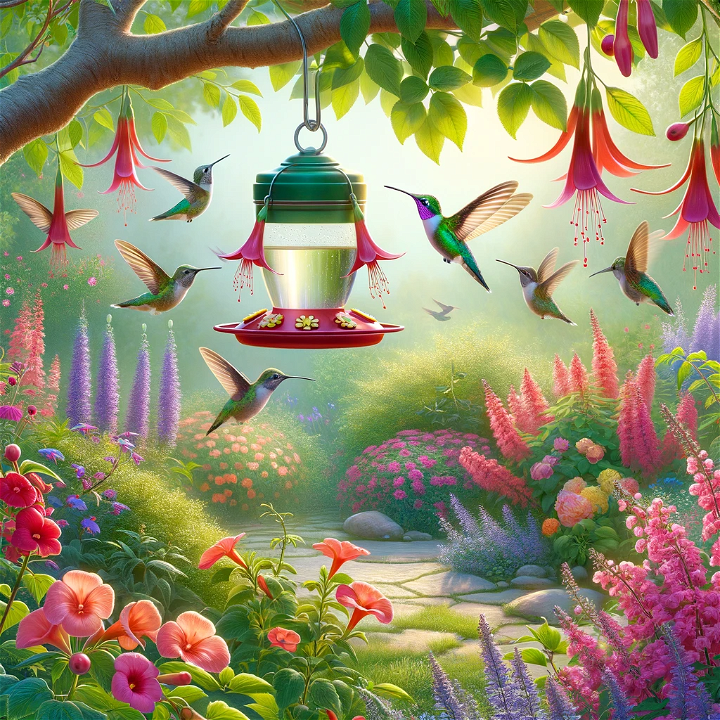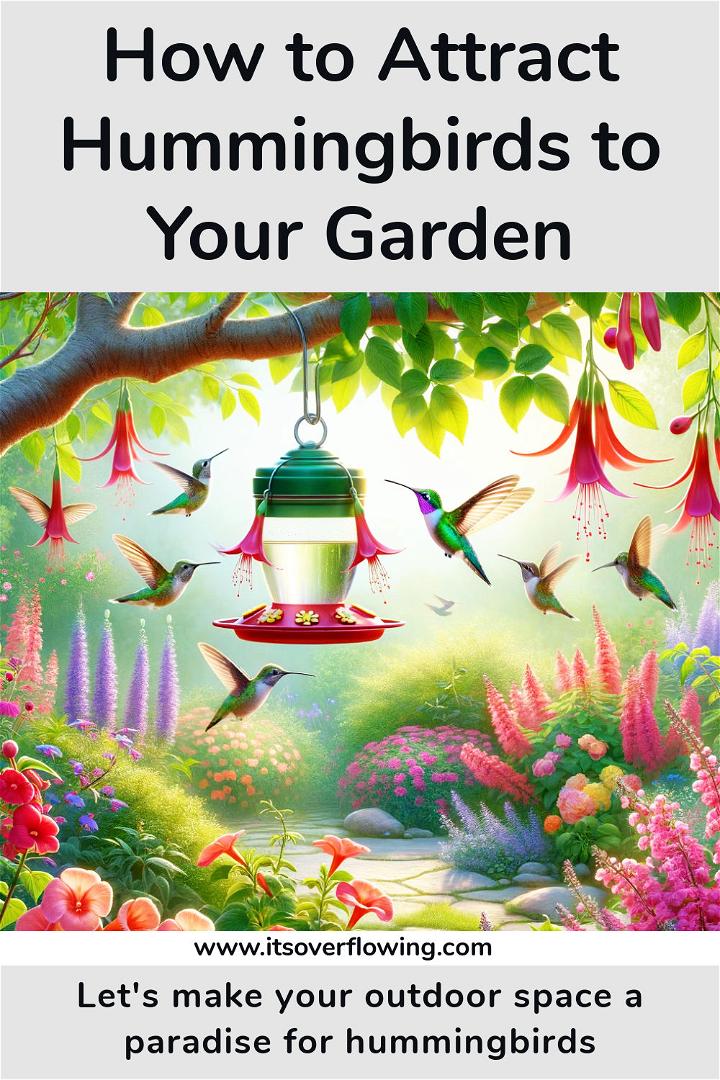Are you tired of your garden feeling empty and lifeless? Do you want to bring more color and vibrancy to your outdoor space? Attracting hummingbirds to your yard is the perfect solution. Not only will these charming birds bring a sense of wonder and joy to your surroundings, but they also play a crucial role in pollination, contributing to the health and diversity of your local ecosystem.
In this blog post, we’ll guide you through essential steps to attract hummingbirds to your yard. From choosing the right flowers and plants to creating a welcoming environment with feeders and water sources, we’ve got you covered. You’ll learn practical tips that will not only entice hummingbirds but also ensure their well-being once they arrive.
So, if you’re ready to transform your garden into a hummingbird haven and experience the delightful sights and sounds of these tiny, iridescent birds, keep reading for expert advice and actionable insights. Let’s make your outdoor space a paradise for hummingbirds!

Planting Hummingbird-Friendly Flowers
Attracting hummingbirds to your garden starts with planting the right flowers. Hummingbirds are drawn to nectar-producing blooms with vibrant colors, ideally red, orange, or pink. Here’s a list of specific flowers that hummingbirds are attracted to, along with their blooming seasons and care requirements:
Selecting the Right Flowers
- Red Columbine: Blooms in late spring to early summer, prefers partial shade, and requires well-drained soil.
- Bee Balm: Flowers from midsummer to early fall, thrives in full sun, and needs regular watering.
- Trumpet Honeysuckle: Blooms from spring to fall, does well in full sun to part shade, and benefits from regular pruning to maintain shape.
- Trumpet Flower: Produces blooms from summer to fall, prefers full sun, and requires rich, well-drained soil.
- Salvia: Flowers from late spring to early fall, thrives in full sun, and needs moderate watering.
- Zinnia: Blooms from summer to frost, requires full sun, and tolerates dry conditions.
Optimizing Flower Colors
The significance of flower colors in attracting hummingbirds is remarkable. Hummingbirds are particularly drawn to red, orange, and pink flowers due to their high visibility and association with nectar-producing blooms. Therefore, consider planting flowers in shades such as:
- Red
- Orange
- Pink
By integrating these vibrant colors into your garden, you can create an inviting environment for hummingbirds. To learn more about the types of flowers that attract hummingbirds, visit Country Living and The Spruce.
Setting Up Hummingbird Feeders
Attracting hummingbirds to your yard can be a delightful experience. When it comes to setting up hummingbird feeders, it’s crucial to consider feeder placement and nectar preparation to provide a nurturing environment for these fascinating birds.
Feeder Placement
Selecting the right location for your hummingbird feeder is essential to attract hummingbirds and ensure their safety. Here are some tips for ideal feeder placement:
- Seek Shade: Position the feeder in an area that receives afternoon shade, protecting it from extreme temperatures. This helps maintain the freshness of the nectar and prevents overheating.
- Nearby Cover: Hang the feeder in proximity to trees or shrubs to provide cover for the hummingbirds, allowing them to perch and rest between feeding sessions.
- Ensure Visibility: Place the feeder where it’s noticeable, catching the light to attract the attention of hummingbirds. They are drawn to vibrant colors, so opt for feeders with red accents to enhance visibility.
- Keep it Clean: Regularly clean and maintain the feeder to ensure a hygienic feeding environment for the hummingbirds.
For more detailed information on feeder placement, you can refer to Birds and Blooms and The Spruce.
Nectar Preparation
Preparing the right nectar is vital for the health and attraction of hummingbirds. Here’s a simple recipe for hummingbird nectar:
- Ingredients: Mix 1 part white sugar with 4 parts water. Boil the mixture to remove impurities if desired, ensuring a pure and safe nectar for the hummingbirds.
- Avoid Additives: Refrain from using red dye or honey in the nectar, as these additives can be harmful to hummingbirds.
- Regular Replacement: Change the nectar every 3-5 days, especially in warmer weather, to prevent fermentation and maintain freshness for the hummingbirds.
For further insights on nectar preparation, visit Audubon and Nature Anywhere.
By implementing proper feeder placement and nectar preparation, you can create an inviting habitat for hummingbirds, enhancing their presence in your surroundings.
Creating a Hummingbird-Friendly Environment
Hummingbirds are delightful little creatures, and you can attract them to your yard by creating a welcoming environment for them. Here are the essential elements to consider:
Incorporating Perches and Shrubs
Hummingbirds need perching spots and suitable shrubs to rest and feel secure. Small branches or twigs strategically placed in your garden provide these tiny birds with resting places. Shrubs and bushes, such as lantana, weigela, and butterfly bush, offer ideal cover and protection. These features offer hummingbirds the opportunity to observe their surroundings and take a break.
Attracting Insects
Insects are a crucial part of a hummingbird’s diet as they provide essential proteins and nutrients. To attract beneficial insects to your garden, consider planting flowers and plants that are known to attract them, such as monarda (bee balm), salvia, and fuchsia. Limiting the use of pesticides also helps maintain a healthy insect population.
Providing Water Sources
Water plays a vital role in attracting hummingbirds to your yard. They not only drink from water sources but also use them for bathing and cooling off. Consider incorporating a shallow bird bath or a small fountain with a dripping or misting feature. This will not only attract hummingbirds but also provide a refreshing oasis for them.
By incorporating perches, attracting insects, and providing water sources, you can create an inviting environment that will attract and nurture hummingbirds in your yard.
For more in-depth tips on attracting hummingbirds, you can refer to the following resources:
- How to Attract Hummingbirds: 10 Expert Tips
- How to Create a Hummingbird-Friendly Yard
- Tips for attracting hummingbirds to your yard
- How to Attract Hummingbirds

FAQs About Attracting and Feeding Hummingbirds
Discover answers to commonly asked questions about attracting and feeding hummingbirds. Learn how to create a welcoming environment for these beautiful creatures.
What plants attract hummingbirds?
Hummingbirds are drawn to:
- Trumpet vine
- Bee balm
- Salvia
- Cardinal flower
- Columbine
- Fuchsia
- Lupine
When is the best time to put out hummingbird feeders?
The best time to put out feeders is:
- Just before the spring migration begins in your area
- As early as late February in the south
- By mid to late April in northern regions
How often should I change hummingbird nectar?
Change nectar every:
- 2 to 3 days in hot weather
- 4 to 5 days when it’s cooler
Can I make my own hummingbird nectar?
Yes! Mix:
- 1 part white sugar with 4 parts water
- Boil the mixture to help prevent mold
What colors are hummingbirds attracted to?
Hummingbirds are especially attracted to the color red, but also to:
- Orange
- Pink
- Yellow
How can I prevent ants and bees from my hummingbird feeder?
To deter ants and bees:
- Use feeders with bee guards
- Apply a thin layer of cooking oil or petroleum jelly to the feeder hanger
- Use ant moats
Where is the best place to hang a hummingbird feeder?
Hang feeders in a spot that:
- Is shaded during the hottest part of the day
- Has a clear view, free from obstructions
- Is near flowers to encourage natural feeding behaviors
How do I clean a hummingbird feeder?
To clean a feeder:
- Take apart the feeder
- Scrub with hot soapy water
- Use a brush for small openings
- Rinse thoroughly
- Let it air dry before refilling
Do hummingbirds prefer feeders or flowers?
Hummingbirds enjoy both feeders and flowers, but they:
- Benefit from the natural nutrition flowers provide
- Enjoy the convenience of feeders
What should I avoid putting in a hummingbird feeder?
Never put:
- Honey or artificial sweeteners
- Red dye
- Anything other than the sugar-water solution
How can I attract hummingbirds to my balcony?
To attract to a balcony:
- Use a small feeder
- Plant hummingbird-friendly flowers in pots
- Ensure the space is safe from predators
How close can hummingbird feeders be to each other?
Feeders should be at least 4-6 feet apart to:
- Reduce territorial behavior
- Give each bird its own space
Can hummingbirds recognize humans?
Yes, hummingbirds can recognize and remember humans, especially those who:
- Regularly refill feeders
- Wear brightly colored clothes
How long does it take for hummingbirds to find a feeder?
It can take from a few days to several weeks for hummingbirds to discover a new feeder. Be patient and keep the feeder clean and full.
Should I use red dye in hummingbird nectar?
No, red dye is unnecessary and could be harmful to hummingbirds. Use clear nectar instead.
Conclusion
Attracting hummingbirds to your yard is a delightful way to invite nature’s beauty into your daily life. By implementing the expert tips discussed in this post, you can create a hummingbird-friendly environment that not only benefits these remarkable birds but also brings joy to your surroundings.
Remember to incorporate a variety of colorful flowers, provide a sugar-water feeder, and include perches for the hummingbirds to rest and observe. By doing so, you will not only attract these fascinating creatures but also contribute to the natural pollination of your garden.
Now is the time to take action! Embrace the simple yet fulfilling experience of attracting hummingbirds and relish the enchanting presence of these tiny, iridescent visitors in your outdoor space. Happy hummingbird watching!
